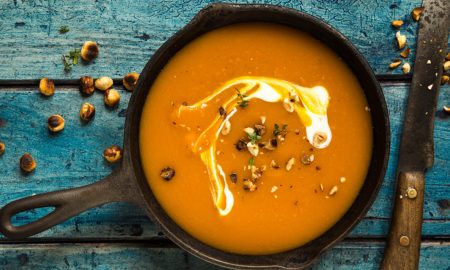KTCHNrebel asked sensory technologist Christine Brugger to provide concrete tips for maximum enjoyment.
What is the difference between taste and aroma?
Brugger Christine: Taste refers to the taste qualities sweet, sour, salty, bitter and umami, which we can sense on the tongue with our taste buds. Aroma is how we perceive all scents and aromas, and there are a million different kinds in nature.

Image: Müller Sylvan | sensory technologist Christine Brugger
Why would it be interesting for producers and restaurateurs to experiment with aroma?
We perceive aroma with the nose via the olfactory mucosa or retronasally, i.e. in the back of the mouth. Aroma is considerably more complex and multi-layered than taste and is directly linked to our memory and emotions. In fact, we can only remember a taste by its scent.
Sourness is said to enhance aroma. Do you have an example of this?
You can clearly see this with apple juice. A simple sweet apple juice is considered to have a less intense aroma than if some lemon juice is added to the same apple juice, for example.
Do sweet and sour pair well together in general?
Yes, they are often used to contrast each other. However, there are other ways to balance sourness and acidity besides adding sweetness such as sugar, honey, thick juices, etc. For example, you can also add flavors that we associate with sweetness such as vanilla or specific fruit flavors, like raspberry and banana. Due to conditioning, the aromas of these spices or fruits are strongly linked to the sensation of “sweet” on the tongue. Therefore, simply smelling the fruit is enough to bring sweetness to mind.
“Aroma is directly linked to our emotions. In fact, we can only remember a taste by its scent.” Christine Brugger, Sensory Technologist

Image: Müller Sylvan
Warmth leads to a more intensive perception of sweetness. Does this mean that you should generally serve sweet dishes or products cold?
Yes, by using a cooler temperature I can influence the sensation of sweetness. The classic example we all know is the difference between ice-cold ice cream versus the sweetness of melted ice cream. I personally prefer a less sweet taste, which is why I store my chocolate in the refrigerator.
How can you strengthen or weaken the umami taste?
If I want to keep the recipe the same, I can also do this through temperature. Glutamic acid from food, which is responsible for the umami taste, behaves similarly to salt. Higher temperatures decrease our perception, while lower temperatures increase our perception. However, interactions do exist between the taste components. As a result, glutamic acid and saltiness reinforce each other in the recipe.
Fat and viscosity slow down aroma perception. Can this be prevented?
Adding sourness results in increasing salivary flow, which thereby leads to a faster distribution and perception of the aromas. Other factors that affect the release of flavor include heating the product, altering the composition of the food, the so-called food matrix, or comminution and surface enlargement. However, fat and viscosity can be used deliberately to create a sensorial tension. If all aromas, taste elements and textures have to be perceived at exactly the same time, our sensory system becomes overwhelmed. Therefore, it is exciting when aromas and flavor facets are released from the food, product or dish with a time lag. A sensory guide for the nose and palate increases the pleasure.
Although carbonic acid can make the aroma fresher, it can also distract from it if it is too strong. What is the best way to deal with this?
Above all, carbonic acid brings out fresh green and fruity aromas more quickly. If you want to emphasize these aroma facets, then using carbon dioxide is an exciting option. If the carbonic acid is too strong – the same is true for spiciness – then our senses are too busy trying to minimize the perceived “danger”. In this case, processing aroma and taste stimuli takes a back seat. This means that if too much carbonic acid, spiciness or cooling elements are involved – i.e. trigeminal stimuli – the perception of aroma and taste is reduced.
What do you mean by trigeminal stimuli?
The sensory complexity of products is usually made up of aroma, taste, texture or mouthfeel and trigeminal perception. With spirits, for example, this refers to the burning, tingly, warming, pungent perceptions of alcohol. It is a kind of stimulus that we perceive via a three-part nerve, which is primarily located around the eyes, nose and palate. In addition to taste and viscosity, trigeminal perceptions are responsible for the characteristic mouthfeel.
During a field test in the Austrian Mostviertel region, they added roasted aromas from dried and roasted pears to the very acidic juice of cider pears. Why?
I suspect that the somewhat harsh climate of the Mostviertel region shapes the products in terms of astringency, much as it does in Normandy. In this case, the fruits often produce polyphenols, i.e. astringent elements, which are also found in the products. This causes our saliva to become thicker, and everything constricts in our mouth. We perceive this as a furry, dry mouth feeling, which you know from wine. Astringency is a chemical stimulus that remains in the mouth for a long time and is difficult to get rid of. The most effective remedy is time. On top of this, however, complex flavors are usually perceived over a longer period of time than less complex flavors. By choosing complex aromas I can create a contrast to the prolonged astringency, in other words, a counter stimulus. The roasted aromas family is complex and ranges from bread to coffee to meat with many sub-facets. Pear wood has therefore given the juice an additional aroma dimension.

Image: Müller Sylvan
Bitterness can be diminished by heat. How can you make use of this?
Bitterness is the taste component that has the greatest differences in individual, personal perception. Some people are extremely sensitive to bitterness while others hardly sense it at all. You can reduce the bitter taste a little bit just by slightly increasing the temperature. For example, a beer that is not completely cool can become a more popular choice for bitter-sensitive people.
It would be fascinating to ask the guest when ordering whether they are bitter-sensitive or not in order to avoid depriving them of a pleasurable experience by choosing the wrong dish or drink.















